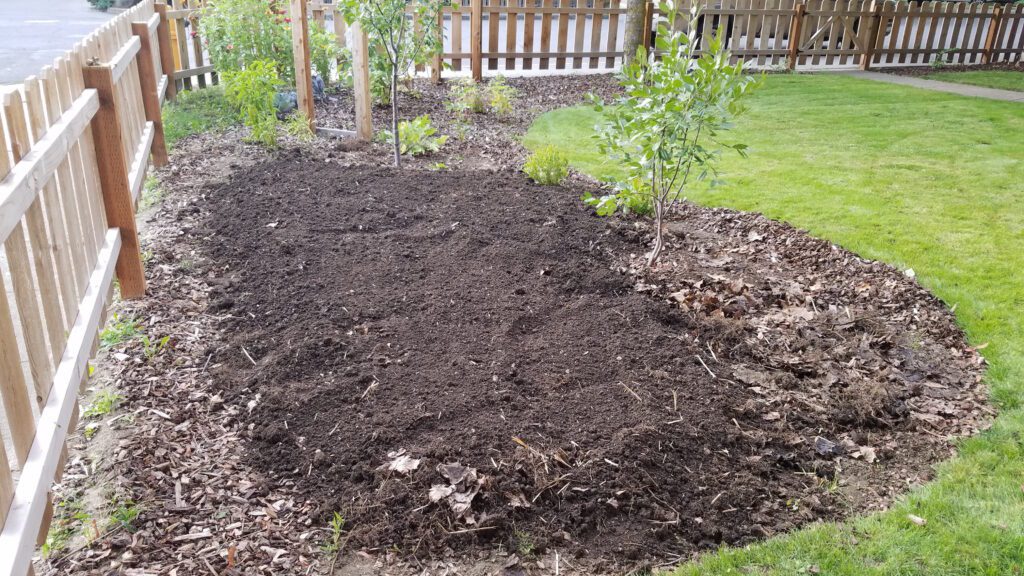Spring is here, but in northern Idaho, it’s still going to be several weeks before we can begin thinking about planting warm-season crops like tomatoes and peppers.
But don’t despair, April is a great month to prepare your garden for the coming season and even plant a variety of cool-season crops that you can harvest before the end of May!

Keep Your Soil Well Fed
Every gardener wants to grow healthy and productive plants. In order to achieve this, we often purchase expensive plant food and fertilizers. Yet, that expense can be greatly reduced or eliminated, if we focus on feeding the soil instead of feeding the plant.
Your soil is full of living organisms – from worms to microscopic fungi – and they’re hungry! Soil organisms breakdown and consume organic matter found in the soil; their nutrient-rich excrement is what feeds our plants and keeps the soil healthy.
Aged compost, a soil amendment rich in organic matter, not only feeds the organisms living in the soil, but it also helps improve soil structure and drainage.



Compost is made from a variety of organic components, including farm animal manure, green-waste (grass and leaves), and food scraps. Good quality compost is dark brown with a clean, earthy smell.
Be cautious using compost that contains municipal bio-solids in your vegetable garden. While this material is safe, it’s best applied to lawns, shrubs, and flower beds; not on edibles.
Applying a two-inch layer of compost on top of the soil in the early spring or late fall will keep your soil fertile and your plants happy and thriving throughout the growing season.
Ready, Set, No-Dig?
For many gardeners, spring prep typically begins with a thorough turning of the soil. But before you pull the rototiller or shovel from the shed, consider taking a no-dig approach to your garden. No-dig simply means minimizing soil disturbance when gardening.
Your soil is the foundation of your garden; healthy soil makes healthy plants. Rototilling or excessive soil-turning can actually do more harm than good. When soil is pulverized by mechanical means, all those beneficial organisms that nourish the soil are destroyed. In addition, soil structure is flattened and the essential space for air and water is depleted.
We may think we are fluffing the soil when rototilling, however, we’re actually compacting and reducing the soil’s viability. And if that wasn’t bad enough, turning the soil brings dormant weed seeds to the surface where they quickly germinate – and no one wants that.
Cool-Season Crops to Plant Now
In early spring, put idle garden space in service by planting cool-season crops. Vegetables such as radishes, lettuce, spinach, kale and peas thrive in cooler growing conditions and some can tolerate light frost.
Another bonus of planting cool-season crops is that many are quick to mature, giving you a harvest before that first tomato plant hits the soil! Here are a few quick-to-harvest veggies to try:
Radishes are rapid producers, providing a harvest in 30 days or less. Direct sow once the soil is workable and plant a new crop once a week to extended the harvest into June.
Lettuce grows quickly and leaves can be harvested in 30 days; full heads in 50 days. Start seed indoors for transplants or direct sow into the garden. Lettuce seed needs light to germinate, so sow seed on top of the soil, cover very lightly, and keep moist.
Spring Onions are usually started from seed indoors about 12 weeks before the last average frost, but many nurseries sell onion sets or seedling transplants. Onion tops can be cut when they are about 6 inches tall for salads. Entire plants can be harvested in about 60 days.



Snap Peas take about 60 to 65 days to mature, however, pea shoots for salads can be snipped once the shoots are 6 to 8 inches tall. Snip the tops and one set of leaves and continue harvesting the top 2 to 4 inches every few weeks. You can get multiple harvests of shoots before letting the plant grow out for snap peas.
Assorted Greens, like Bok choi, kale, arugula, spinach, and chard grow extremely well in the cool spring. Most can be harvested as baby greens around 30 days or grown to maturity in as little as 60 days.


Once your cool-season vegetables are planted, keep an eye on the weather. Spring weather is unpredictable and even though these crops thrive in cool conditions, young seedlings may need protection until they are established. Frost cloth, cloches, a cold frame, or low tunnel will offer good protection from unseasonably cool nights.


Show you soil some love this spring by giving it a good feeding with quality compost and minimizing the amount of digging you do. Then, put those garden beds work by planting cool-season veggies and enjoy your first harvest of the season by Memorial Day!



Leave a Reply